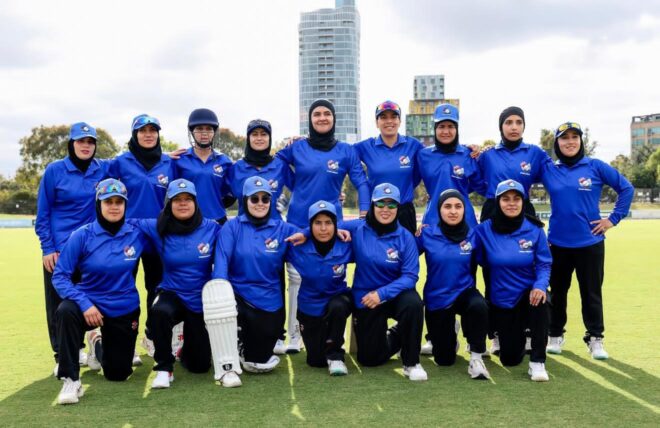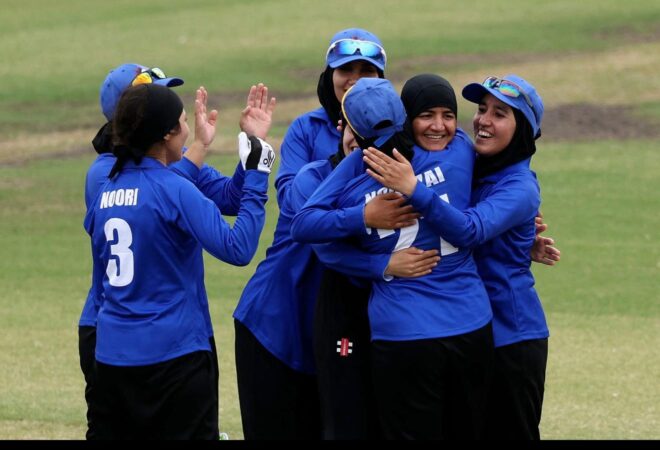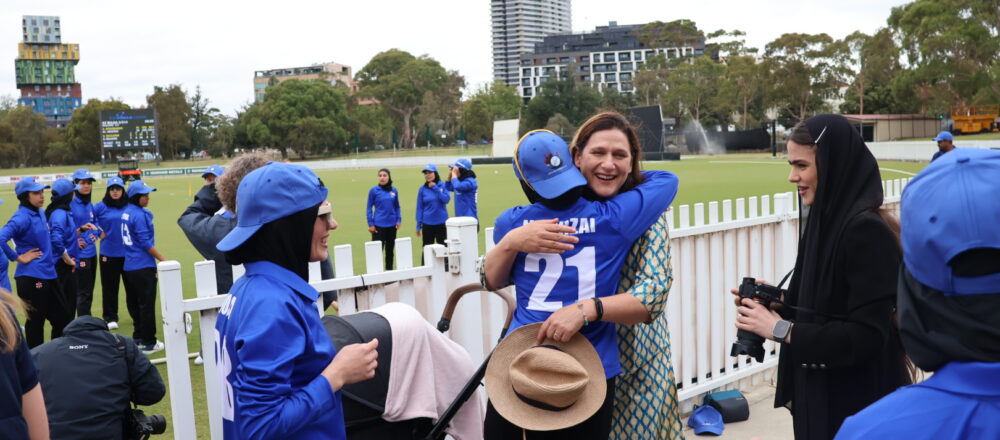In August 2021, millions of Afghan women’s dreams were crushed as the Taliban swept through the country, seizing control after the U.S. military withdrawal.
Among them were Afghanistan’s national women’s cricket team, who had signed professional contracts with the Afghanistan Cricket Board just a year earlier. Suddenly, their sporting achievements became evidence that could endanger their lives.
Thousands of kilometres away, Associate Professor Dr Catherine Ordway was preparing to teach the human rights module of her long-running Sport Integrity, Ethics and Law course at the University of Canberra, when she came across a story about the Afghan women’s football team’s evacuation to Australia.
“I knew a number of the women that were involved in that [evacuation] process,” Ordway recalls. “So, I reached out to all of them, and to Tracey [Holmes], who wrote the story, and said, ‘How can my class help? Can we fundraise? Support them?’”
Holmes told her the footballers were safe, but another team was still stranded.
“[Tracey] said, ‘The women’s cricket team is stuck inside [Afghanistan] and nobody’s helping them. Can you do something to get them out?’”
Ordway’s honest response was, “I don’t know how.”
But Holmes urged her: “Find a way.”
The Phone Call That Changed Everything
Ordway was no stranger to battling for women’s rights, dedicating much of her career to empowering women in sports leadership and helping achieve the International Olympic Committee’s aim of 20% women on National Olympic boards. A leading sports lawyer and trusted advisor to international sporting bodies, she had spent decades pushing for integrity and inclusion in sport.
But this was uncharted territory. She began by trying to identify who the players were and whether they even wanted help. “I absolutely didn’t want to be a white woman saviour coming in and telling them what they needed,” she says.
“I thought ok … let’s find out how to do this. I needed to find out, first of all, who were the team?” Ordway recalls. “I wanted to find out who are they? Did they, in fact, want help? Was somebody else already helping them?”
After reaching out to contacts in the sports industry, she found the email and phone number of Afghan cricketer Benafsha Hashimi. Her introductory email went unanswered.
“Who would answer that? You’re in a war zone, and some random [lecturer] is writing to you. I wouldn’t answer that either,” she admits.
But when she rang the number, another young woman answered.
“I asked if it was Benafsha and she said ‘no’, and I thought ‘oh dear’. Then I said ‘ok, do you know Benafsha?’
“She said, ‘Yes, I know Benafsha … I’m the opening batter, and she plays in the team with me.’”
On the line was Sofia Yousufzai, one of the 25 Afghan women cricketers with professional contracts.
“I spoke to her from my backyard in Canberra. It was late at night, and I could hear what sounded like gunfire in the background,” Ordway recalls. “I had to kind of ask this trite, stupid question, which was, ‘Are you ok?’ And she said, ‘No, we’re not ok.’”
When Ordway asked Sofia if she and the team wanted to escape, the answer was clear: “Absolutely, we want to do that.”
Destroying Evidence, Facing Threats
For the players, survival meant erasing their sporting past.
“As soon as the Taliban took Kabul, we had to destroy all evidence,” Firooza Amiri told Sport Star. “If they discovered kit belonging to a girl, the family would be killed. I burnt everything – my medals, my kit, everything I had achieved in six years.”
Another player, Nahida Sapan, told BBC Sport that Taliban fighters came searching for her at home. “My brother was asked, ‘Do you know about some cricket girl? We think she lives here.’ … They were saying: ‘We will find you and if we find you, we will not let you live. If we find one of you we will find all of you.’”
For these women, staying meant silence or death. Leaving was their only option.
The Escape
With the help of Sofia and Benafsha, Ordway established contact with the rest of the squad. Their contracts became critical evidence. Without passports or IDs, they proved the women were legitimate athletes.
Eventually, 22 players were identified for evacuation, alongside family members and staff. In total, 130 Afghans were approved for emergency visas.
But to reach Pakistan, they would have to pass 25 to 28 armed checkpoints.
For Ordway, someone whose career had mostly unfolded in courtrooms, lecture halls and boardrooms, orchestrating a covert evacuation through war zones was something entirely new – yet she refused to turn away. Her determination, resourcefulness and network proved life-changing for dozens of families.
She tapped into security contacts from her time in Doha, including former trainers of Afghan security forces. “Some of those extremely brave people, in two cases women, drove the cars for the players and their families,” she says.
Crossing the border grew harder each day as Pakistan shifted its policies. “They required tourist visas, written in English, out of a war zone. Can you imagine? You had to write it in English, most of these people did not have English. You had to have a passport, most of them didn’t have a passport… [and] how did you get a passport photo?
“I was directing them on WhatsApp: ‘Hold up a sheet behind your head, get someone to take a photo, send it to me.’”
Working with former Australian cricket star Melanie Jones and administrator Emma Staples, Ordway improvised solutions at every hurdle. “It was pretty much an all-woman operation,” she says.
A New Life in Australia
Against all odds, all 130 visa-holders reached Australia. But resettlement came with challenges such as language barriers, cultural adjustment, and the pain of leaving loved ones behind.
For these refugees, Afghanistan is never far from their minds, especially the people who they had to leave behind. The UN Women’s Gender Index for 2024 ranked Afghanistan as the country with the second widest gender gap in the world, and recently stated that, “The Taliban is closer than ever to achieving its vision of a society that completely erases women from public life.”
Still, the young athletes rebuilt, studying English, enrolling in university, and finding jobs. Most importantly, they found their way back to cricket in local leagues across Melbourne and Canberra.

In January 2025, three and a half years after their flight, they reunited as a team. The Afghanistan Women’s XI played the Cricket Without Borders XI in a special exhibition match at Melbourne’s Junction Oval.
“We’re doing this for all Afghan women,” said player Shazia Rahman Zazai. “To tell them to be proud of themselves and that they are the strongest women in the world. Please don’t give up.”
The game drew widespread media coverage and finally prompted action from the International Cricket Council. In April, the ICC announced a dedicated task force, with support from Cricket Australia, the BCCI and the ECB, to provide resources and facilities for displaced Afghan women cricketers.
Carrying the Torch
Ordway called the ICC’s move a “brilliant first step.” Melanie Jones and Emma Staples also launched the Pitch Our Future campaign, aiming to raise AUD $1.5 million to fund a three-year program for the players’ training and wellbeing.
In recognition of their extraordinary efforts to help these Afghan women escape, Ordway, Jones, and Staples were recently awarded the Marylebone Cricket Club’s Spirit of Cricket Award – an honour rarely given to non-players.
But for Ordway, the real reward is seeing the team back on the pitch. More importantly, she says, they are now pursuing education, employment and opportunities that would have been impossible had they remained in Afghanistan.
“All of this was only possible because we had trust and love,” she says. “Love wins, that’s the message I think we have here.”
Player Tooba Khan Sarwari told Right Now, “We really appreciate those people … like Miss Catherine, Mel Jones and Emma Staples. They took on a big responsibility… [and] we got over the border… and we are very thankful.
“Catherine, she is speaking about Afghan women’s right[s] … [and the] Afghan cricket team. And she supported [us] a lot when we came to Australia.
“If we didn’t have these kinds of ladies… this [escape] would not happen. Nobody [would be] talking about us. They are the reason that it’s happened for us.”

Firooza Amiri wrote on LinkedIn, “We call them life savers—women who didn’t just save 130 lives, but gave hope to countless others. Girls who may not live in Australia, but now live with the belief that someone, somewhere, is fighting for them. That their lives can change. That their dreams still matter.
“From me and the entire team, thank you Emma Staples, Catherine Ordway and Melanie Jones, your support means more than words can ever express.”
But Ordway and the players are also quick to point out that beyond this incredible story, there are still so many women inside Afghanistan who are banned from sport as well as most jobs and education beyond Grade 6. In many parts of the country, they cannot go outside without a male guardian and are forbidden from speaking in public.
“I don’t want to celebrate too hard, because, of course, there are still vulnerable people living in Afghanistan, so I just want to be conscious about that”, Ordway says.
“[The players] want to be able to use this as a platform and to [continue] push[ing] forward … [and] give this opportunity to all their sisters and compatriots who are sitting at home not being able to play cricket … [or] get access to education and work.”
For Ordway, this is not the end of the story but the beginning of a wider mission. That is, ensuring that sport continues to be a vehicle for hope, dignity and opportunity for women everywhere, even in the darkest of times.


